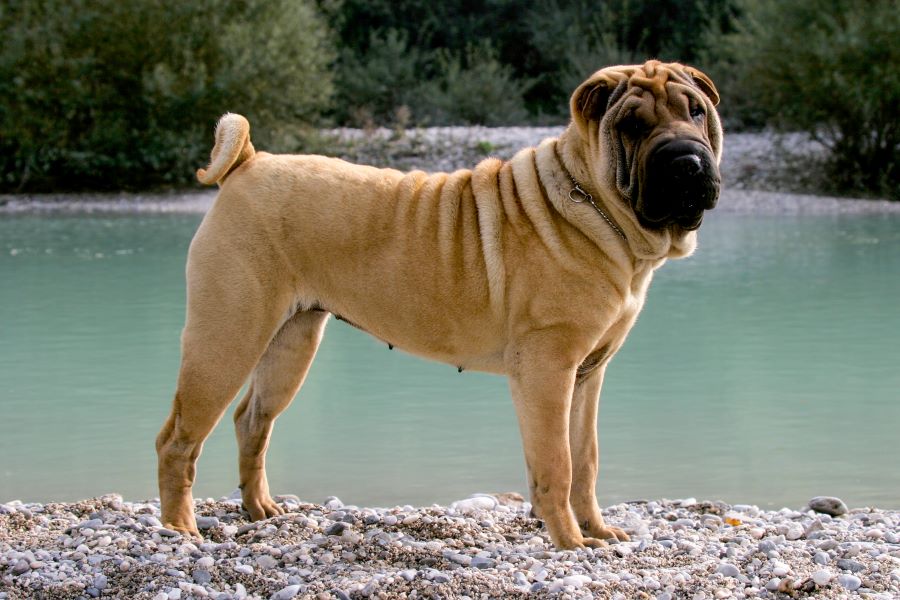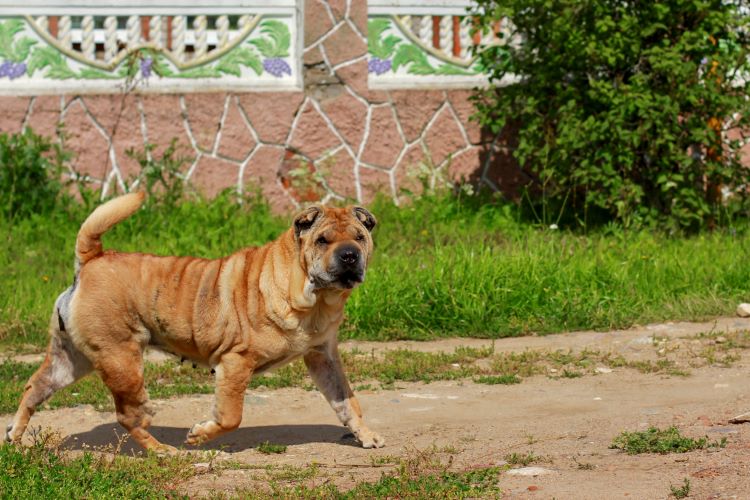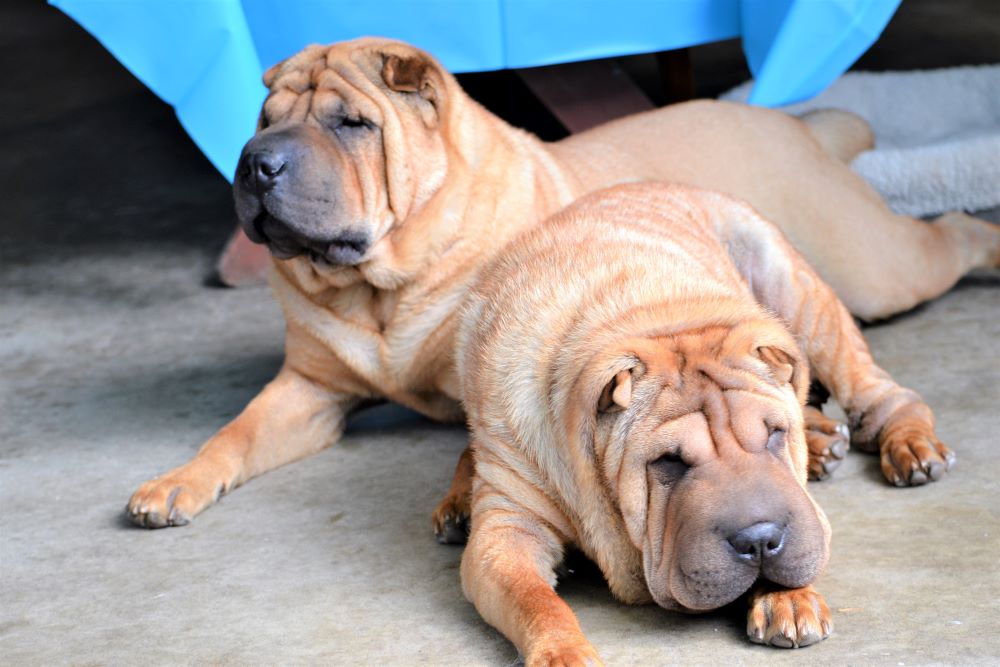Get Pet Insurance for your Cat & Dog

Zero
Documentation
Quick
Claim Process
Affordable
Premium
Terms and conditions apply*
- {{species}}
- {{indoorOutdoor}}
- {{suminsured}}
Chinese Shar Pei Dog Breed Characteristics & Information

Chinese Shar Pei dogs, with their distinctive wrinkles and unique appearance, have captured the hearts of dog enthusiasts worldwide. These dogs have a rich history and characteristics that make them stand out among other breeds.
This article will explore their defining characteristics, learn about proper care and training techniques, and address common health concerns.
What Defines Chinese Shar Pei Dogs?
The Chinese Shar Pei is an ancient breed with roots tracing back to the Han Dynasty in China, around 200 B.C. Unknown to many, "Shar Pei" translates to "sand skin," a nod to their distinctive wrinkled coat.
Chinese Shar Pei dogs can make good pets. They appreciate moderate attention and can be independent. While their unique personality can make them a rewarding choice, they might not be the easiest for first-time dog owners due to their strong-willed nature.
What are the Characteristics of Chinese Shar Pei Dogs?

Understanding the characteristics of Chinese Shar Pei dogs is key to forming a strong bond with these loyal companions.
- Lifespan: On average, Chinese Shar Pei dogs have a lifespan of 9 to 12 years, depending on various factors such as genetics, diet, and overall care.
- Height: Adult Shar Peis typically stand between 18 to 20 inches at the shoulder, showcasing a sturdy and compact build.
- Colour: The breed exhibits a diverse range of colours, including fawn, cream, black, lilac, and chocolate. They have blue-black tongues.
- Weight: Adult Chinese Shar Pei dogs usually weigh between 20 to 27 kg, making them a medium-sized breed.
- Behaviour and Personality: They are known to be quiet and not overly affectionate. They can be good with kids and might be reserved around other pets.
- Living Condition: As long as they receive daily walks, these pets can be good in an apartment and may enjoy spending extra time outdoors in the fall or winter.
- Coat: They have short and bristly coats. Their coats can be solid or have a sable pattern. They have a distinctive broad “hippopotamus” muzzle.
- Breed Group: Shar Peis belong to the Non-Sporting group, emphasising their versatility and distinct characteristics.
- Temperament: They exhibit a calm and confident temperament but can be reserved and suspicious with strangers, showcasing their protective instincts.
How to Train Chinese Shar Pei Dogs?

Chinese Shar Pei dogs are easy to train and are not known as dogs with high energy levels.
- Teach Basic commands: Start early with basic commands like sit, stay, and come. Consistency and positive reinforcement work well with their independent nature.
- Agility Training: Shar Peis love agility activities that test their mental and physical stamina. It's a wonderful method to maintain engagement and bond with them.
- Tracking: Shar Peis excels in tracking activities, given their strong sense of smell. Hide treats or toys for them to find, promoting mental stimulation.
- Show that You Are the “Top Dog”: Establishing yourself as the leader through consistent training and clear communication helps prevent dominance-related issues.
- Behavioural Training: Address any undesirable behaviours early on through positive reinforcement. Consistent training helps shape their behaviour.
- Early Socialisation: From an early age, introduce your Shar Pei to various people, places, and animals. As they get older, this prevents them from shyness or violence.
What are the Health Problems with Chinese Shar Pei Dogs?
Responsible owners must be informed of potential health problems specific to Chinese Shar Pei dogs that they are prone to. Here are five common health problems:
- Skin Problems: Chinese Shar Pei dogs are prone to skin issues due to wrinkles. Regular cleaning and monitoring help prevent infections and dermatitis.
- Shar Pei Fever: A hereditary condition requiring immediate veterinary care. Symptoms include lethargy, swollen hocks, and a reluctance to move.
- Entropion: Entropion, a condition where the eyelid rolls inward, is common in Shar Peis. Regular eye checks and prompt veterinary attention are necessary.
- Renal Amyloidosis: This kidney condition can affect Shar Peis. Regular veterinary check-ups and a healthy diet contribute to kidney health.
- Hypothyroidism: This is a thyroid gland condition in Shar Pei. Epilepsy, alopecia (hair loss), obesity, pyoderma, and other problems are believed to be caused by it.
How to Take Care of Chinese Shar Pei Dogs?
Chinese Shar Pei dogs are a relatively high-maintenance breed, and it is essential to keep them healthy. Here are a few tips to keep them healthy and happy:
- Diet and Nutrition: A Chinese Shar Pei's diet includes a combination of chicken, bone, meat, and a limited food that includes plant-based ingredients
- Feeding: A full and well-balanced dog diet is recommended for Shar Peis. Between 1.5 and 2.5 cups of dry food daily, divided into two meals.
- Grooming: Weekly grooming, including brushing their short coat. Paying attention to their ears, teeth, and nails is also vital.
- Exercise: While they don't require extensive exercise, daily walks and playtime are essential to stimulate Shar Peis physically and mentally.
- Folds of Skin: Regular cleaning and drying of the folds in their skin prevent infections and maintain their distinctive appearance.
- Bathing: Give your dog a bath once a month or more often if they roll in something smelly. Use dog-friendly shampoo and soap.
- Eye Care: Shar Peis are prone to eye issues due to their loose eyelids. Regular cleaning and monitoring can help prevent infections.
Chinese Shar Pei dogs bring a unique blend of history, distinctive characteristics, and loyal companionship. Proper care involves attention to their diet, grooming routines, and regular exercise. As devoted companions, Chinese Shar Pei dogs bring joy and uniqueness to the lives of those who appreciate their special qualities.












